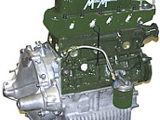1275cc A Series Engine Color Schemes Only engines bearing a 12CC engine no. prefix
were painted in British Motor Corporation Engine Green(the color somewhere between sage green
and olive green applied to the power units in most BMC motor vehicles, including all the
Sprite and Midget variants prior to 1967). This equates to roughly the first year of 1275 production.
Following this (from 1968 to 1971) came the 12CD and subsequent 12CJ units, both peculiar to
emission-controlled cars bound for the North American market place; during this period the rest
of the world received Sprites and Midgets with 12CE engines. All three of these engine types
were painted in a very pale silvery-green; the color was the same as that which was then being
applied to engines in MGC’s and their predecessors (?) the Austin Healey 3000’s.
From late 1971 to the end of 1275 Midget production (the manufacture of Sprites by this point had finished),
all cars were fitted with variants of the 12V engine range. The 12V engines were a fairly successful attempt
by British Leyland to rationalize the build specifications of the myriad of 1275cc engine
variants currently being used. In true Henry Ford tradition, from late 1971 onwards,
all engines were black. This state of affairs continued past the end of Midget production
until the beginning of the 1980’s and the introduction of the considerably modified ‘A+’ engines for
use in the Metro, Mini, Ital, etc. It’s also a fact that whatever the colors or natural unpainted finishes
of the engine ancillaries were when they left their respective manufacturers, once they were fitted to a
new engine they were at least unintentionally oversprayed if not deliberately painted the same color as the engine.
This statement applies to thermostat housings (‘elbows’), inlet manifolds, water pump, heater cap,
plug leads, spark plugs, oil filler cap and spin on oil filter cartridges were sometime camouflaged,
although of course they reverted to their more contrasting color schemes as the vehicle was serviced.
The only power unit item over which care was taken to preserve its color was the cooling fan.
For safety reason, naturally, the cooling fan was always finished in high visibility chromium yellow;
early vehicles carried a painted metal fan, later vehicles having a self colored plastic time.
The gearbox, which was also attached to the engine on the power unit production line, more
often than not also left the line in the same color as the engine. Two more color schemes should
probably be discussed here. Factory remanufactured (it gave a better impression than calling them ‘reconditioned’)
exchange units were for many years, in fact back through BMC days, known as Gold Seal units and therefore painted….metallic gold.
At the end of the 1970’s a range of second condition remanufactured units were launched under the banner of Silver Seal.
Units offered in the Silver Seal scheme were (wait for it) silver, which looked very similar to texture to the
ubiquitous hammered finish enamel you see in your local accessory shop.
The major units (engines and gearboxes) were completely painted in gold or silver,
while lesser units (starter motors, dynamos, etc) were finished in gold and satin black for Gold Seal,
or natural metal and satin black for Silver Seal.







